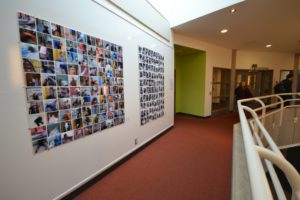Taking 100 photographs and then arranging them in an artistically sound way is no small task, but that’s what Camosun Visual Arts students have done in Typologies, an exhibit up at the Lansdowne campus until December 6.
Camosun Visual Arts instructor Nancy Yakimoski says watching the wide array of creative property that students come up with never gets old, and that there is more to the art than what initially meets the eye.
“They had to select one particular object or subject matter, and then take 100 different images of it,” she says. “The typology is creating these 100 separate images, so when you look at the separate image, there’s something in each image that is interesting, but then when you take a step back and see it within the context of 99 other images, you see that in a different way.”
Assembling 100 photographs together so that they capture new and exciting meanings when viewed as a whole is a very different process than taking separate images, says Yakimoski, who adds that new artistic elements become apparent when you view a photograph as a typology. Yakimoski says her role as instructor is often to instil a sense of artistic freedom in her students; whether they want to take photos with their phone or with a fancy Nikon, she tries not to influence the students’ processes too much after the initial instruction.

“Whatever you find interesting and think would make a good typology, you know, go crazy,” she says.
There is never a dull moment in Yakimoski’s class as a result of the freedom that she works hard to incorporate into her teaching.
“In previous years, my gosh, we’ve seen 100 tongues, 100 nipples, 100 photographs of landscape shot through a piece of red glass,” she says. “I just open the door, and it’s like, ‘Okay, show me what you can do.’”
Camosun Visual Arts student Wynonna Hess created her typology out of items people had in their pockets: keys, wallets, toy dolphins. She says the hardest part of the project was finding the courage to walk up to complete strangers and ask if she could take photos of their belongings.
“It was a lot of cell phones, but was also a lot of random things that they were almost excited they had been carrying around with them,” she says. “At one point somebody had a miniature shark in their pocket; [people had] little trinkets, wallets, and even food.”
Hess approached people over different periods of time, and she says she wanted her arrangement to be “sporadic” to represent the time period over which the photos were taken.
“Mine was about 100 different interactions with people,” she says about her typology, “and what they deemed important enough to show me. When it was all completed and printed out and had to be arranged, I didn’t have much thought other than the occasional mashing of colour in different images, because the picking of people was so sporadic that I wanted the arrangement to be sporadic as well.”
Typologies
Until Tuesday, December 6
Lansdowne library mezzanine and beside Young 111
